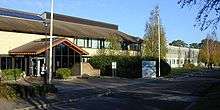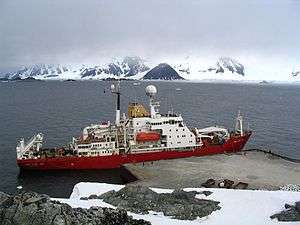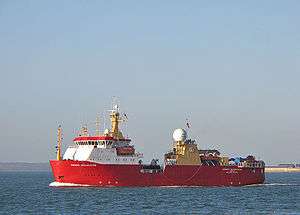British Antarctic Survey
 | |
| Abbreviation | BAS |
|---|---|
| Formation | 1962 |
| Legal status | Government Organisation |
| Purpose | Carry out scientific research and surveys in the Antarctic |
| Headquarters | BAS Headquarters |
| Location |
|
Region served |
|
Director | Professor Jane Francis |
Parent organisation | Natural Environment Research Council |
Budget | £48,053,000 (2011-12)[1] |
Staff | 400+ staff |
| Website |
www |
The British Antarctic Survey (BAS) is the United Kingdom's national Antarctic operation and has an active role in Antarctic affairs. BAS is part of the Natural Environment Research Council (NERC) and has over 400 staff. It operates five research stations, two ships and five aircraft in and around Antarctica.[2] BAS addresses key global and regional issues. This involves joint research projects with over 40 UK universities and more than 120 national and international collaborations.
History
Operation Tabarin was a small British expedition in 1943 to establish permanently occupied bases in the Antarctic. It was a joint undertaking by the Admiralty and the Colonial Office. At the end of the war it was renamed the Falkland Islands Dependencies Survey (FIDS) and full control passed to the Colonial Office. At this time there were four stations, three occupied and one unoccupied. By the time FIDS was renamed British Antarctic Survey in 1962, 19 stations and three refuges had been established.[3]
In 2012 the parent body, NERC, proposed merging the BAS with another NERC institute, National Oceanography Centre in Southampton.[4] This proved controversial, and after the House of Commons Science and Technology Committee opposed the move[5] and the plan was dropped.[6]
Directors

- 1945–1948: The Arctic and Antarctic explorer Surgeon Captain Edward W. Bingham was Director of FIDS
- 1958–1973: The Antarctic explorer Sir Vivian Fuchs was Director of FIDS/BAS/
- 1973–May 1987: Richard Laws[7][8]
- 1987–1994: David Drewry[9]
- 1994–1997: Barry Heywood
- 1998–2007: Chris Rapley[10]
- 2007–May 2012: Nick Owens[11][12]
- November 2012–September 2013: Professor Alan Rodger, Interim Director[13]
- October 2013: Professor Jane Francis[13][14][15]
Research Stations
Research Stations in Antarctica
The BAS operates five permanent research stations in the British Antarctic Territory:[16]
- Rothera Research Station on Adelaide Island
- Halley Research Station on the Brunt Ice Shelf
- Signy Research Station on Signy Island
- Fossil Bluff Logistics Facility on Alexander Island
- Sky Blu Logistics Facility in Ellsworth Land
Of these Research Stations, only Rothera and Halley are manned throughout the year.[17] The remaining bases are manned only during the Antarctic summer.
Research Stations on South Georgia
The BAS also operates two permanent bases on South Georgia:[16]
- King Edward Point Research Station at King Edward Point
- Bird Island Research Station on Bird Island
Both South Georgia bases are manned throughout the year.
Other sites

The headquarters of the BAS are in the United Kingdom, in the university city of Cambridge, on Madingley Road. This facility provides offices, laboratories and workshops to support the scientific and logistic activities in the Antarctic.[18]
The BAS also operates the Ny-Ålesund Research Station on behalf of the NERC. This is an Arctic research base located at Ny-Ålesund on the Norwegian island of Spitsbergen.[19]
Equipment
Ships

BAS operates two ships in support of its Antarctic research programme. Whilst both vessels have research and supply capabilities, the RRS James Clark Ross is primarily an oceanographic research ship, whilst RRS Ernest Shackleton is primarily a logistics ship used for the resupply of scientific stations.[20] James Clark Ross replaced RRS John Biscoe in 1991 and Ernest Shackleton was the successor to RRS Bransfield in 1999.[21]
Both vessels depart from the United Kingdom in September or October of each year, and return to the United Kingdom in the following May or June. Both vessels undergo refit and drydock during the Antarctic winter, but are also used elsewhere during this period. James Clark Ross often undertakes scientific research on behalf of other organisations in the Arctic, whilst Ernest Shackleton is chartered into commercial survey work.[20]
The two civilian ships operated by the BAS are complemented by the capabilities of the Royal Navy's ice patrol vessel that operates in the same waters. Until 2008 this was HMS Endurance, a Class 1A1 icebreaker. Endurance's two Lynx helicopters enabled BAS staff to get to remote field sites that BAS aircraft could not access.[22] However, a catastrophic accident left Endurance badly damaged, with a replacement only being procured in 2011. This ship, HMS Protector, first deployed to the Antarctic in November 2011.[23]
In April 2014 the government authorised the procurement by BAS of a new large Antarctic research vessel at an estimated cost of £200 million, expected to be in service in 2019.[24]
Aircraft

BAS operates five aircraft in support of its research programme in Antarctica. The aircraft used are all made by de Havilland Canada and comprise four Twin Otters and one Dash 7. The planes are maintained by Rocky Mountain Aircraft in Springbank, Alberta, Canada. During the Antarctic summer the aircraft are based at the Rothera base, which has a 900-metre gravel runway. During the Antarctic winter, conditions preclude flying and the aircraft return to Canada.[25]
The larger Dash 7 undertakes regular shuttle flights between either Port Stanley Airport on the Falkland Islands, or Punta Arenas in Chile, and Rothera. It also operates to and from the ice runway at the Sky Blu base. The smaller Twin Otters are equipped with skis for landing on snow and ice in remote areas, and operate out of the bases at Rothera, Fossil Bluff, Halley and Sky Blu.[25]
Findings

In January 2008, a team of British Antarctic Survey scientists, led by Hugh Corr and David Vaughan, reported that 2,200 years ago a volcano erupted under Antarctica's ice sheet (based on airborne survey with radar images). The biggest eruption in the last 10,000 years, the volcanic ash was found deposited on the ice surface under the Hudson Mountains, close to Pine Island Glacier.[26] The British Antarctic Survey are also responsible for the discovery of the hole in the ozone layer over Antarctica. The discovery was made in 1985 by a team of three BAS scientists named Joe Farman, Brian Gardiner and Jonathan Shanklin. Their work was confirmed by satellite data, and was met with world-wide concern.[27]
Polar Image Collection
The British Antarctic Survey BAS run an Image Collection, which includes imagery of BAS Scientific Research at the Poles, BAS logistics as well as images that show the continent and its wildlife. The BAS Image Collection is run by British cameraman and photographer Pete Bucktrout who has visited the Continent 11 times during his 24 years working for BAS. His work has been seen in TV News reports around the world and in most, if not all, international broadsheet newspapers. The collection can be accessed via the BAS Image Portal at www.photo.antarctica.ac.uk
See also
- British Antarctic Territory
- Faraday Research Station
- Halley Research Station
- List of organizations based in Antarctica
- National Antarctic Program
- Rothera Research Station
References
- ↑ "Business Plan 2011" (PDF). British Antarctic Survey. Retrieved 3 September 2012.
- ↑ "Who We Are". British Antarctic Survey. Retrieved 11 November 2007.
- ↑ "British Research Stations and Refuges - History". British Antarctic Survey. Retrieved 11 November 2007.
- ↑ McKie, Robin (29 September 2012). "Antarctic research at risk as government cuts back on science". The Observer. Retrieved 4 November 2012.
- ↑ "Think again on British Antarctic Survey merger say Science and Technology Committee". UK Parliament Website. 31 October 2012. Retrieved 4 November 2012.
- ↑ Carrington, Damian; McKie, Robin (4 November 2012). "Research boss Wingham in trouble over British Antarctic Survey claim". The Observer. Retrieved 4 November 2012.
- ↑ Roberts, Brian (January 1974). "New director of the British Antarctic Survey: Dr R.M. Laws". Polar Record. 17 (106): 49. doi:10.1017/S0032247400031375. Retrieved 4 November 2012.
- ↑ "Laws Prize 2012". British Antarctic Survey Club. Retrieved 4 November 2012.
- ↑ "Professor David J Drewry". Anglia Ruskin University. Retrieved 4 November 2012.
- ↑ Randerson, James (31 August 2007). "Profile: Chris Rapley". The Guardian. Retrieved 4 November 2012.
- ↑ "New Director for the British Antarctic Survey". British Antarctic Survey. Retrieved 4 November 2012.
- ↑ "NOC welcomes Nick Owens appointment as SAHFOS Director". National Oceanography Centre. 10 May 2012. Retrieved 4 November 2012.
- 1 2 "British Antarctic Survey has a new director: climate expert Professor Jane Francis". Merco Press. 2013. Archived from the original on 23 October 2014. Retrieved 23 October 2014.
- ↑ "The BAS Executive Team". bas.ac.uk.
- ↑ "BAS PSPE Organisation 28 November 2012" (PDF). antarctica.ac.uk.
- 1 2 "Research Stations in Antarctica". British Antarctic Survey. Retrieved 31 December 2007.
- ↑ Blake, David (September 2005). "Extreme Engineering". Ingenia (24). Retrieved 28 March 2010.
- ↑ "BAS Cambridge". British Antarctic Survey. Retrieved 31 December 2007.
- ↑ "Ny-Ålesund Arctic Research Station". British Antarctic Survey. Retrieved 2 January 2008.
- 1 2 "Research Ships". British Antarctic Survey. Retrieved 31 December 2007.
- ↑ "RRS Bransfield - History". British Antarctic Survey. Retrieved 28 March 2010.
- ↑ "HMS Endurance — Ice Patrol Vessel". British Antarctic Survey. Archived from the original on 7 June 2011. Retrieved 31 December 2007.
- ↑ "Protector sails on her debut voyage to the ice". Royal Navy. Retrieved 1 December 2011.
- ↑ "£200 million floating laboratory will explore 'final frontier' of polar regions". The Telegraph. 25 April 2014. Retrieved 30 April 2014.
- 1 2 "Aircraft in Antarctica". British Antarctic Survey. Retrieved 31 December 2007.
- ↑ Black, Richard (20 January 2008). "Ancient Antarctic eruption noted". BBC News. Retrieved 28 March 2010.
- ↑ "The Ozone Layer". British Antarctic Survey. 18 May 2015. Retrieved 30 November 2015.
External links
| Wikimedia Commons has media related to British Antarctic Survey. |
- Official website
- Polar Picture Library
- Discovering Antarctica — teaching and learning resources on Antarctica
- BAS science programmes
- BAS research stations
- BAS Online Palaeontology Collection

